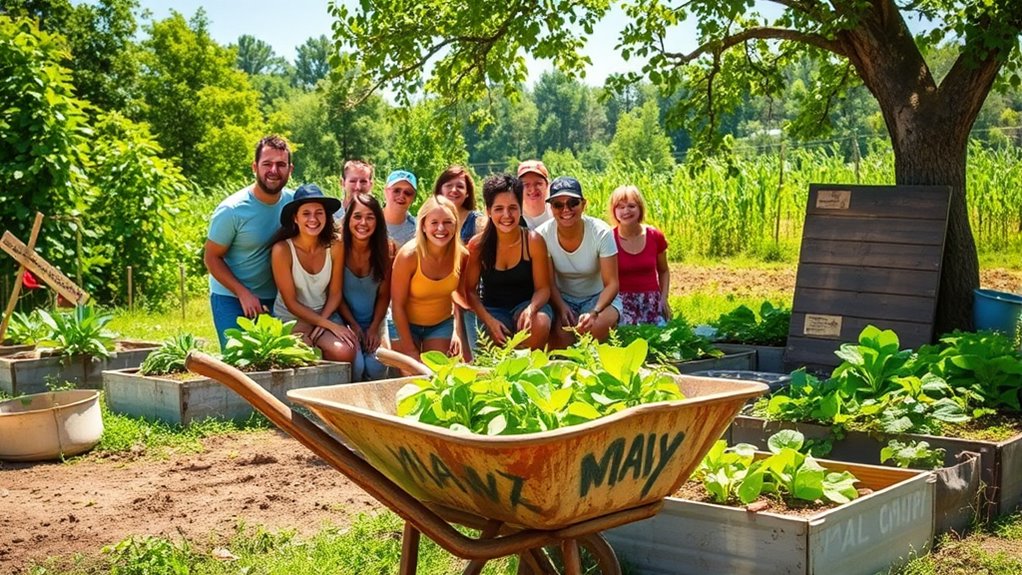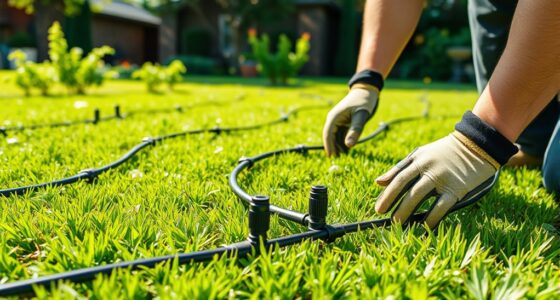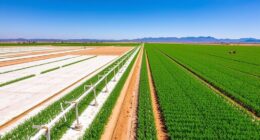You can start farming with no money by assessing your available resources, like soil quality and water supply, and exploring land acquisition strategies such as leasing or owner financing. Choose low-cost crops like legumes and easy-to-grow vegetables to minimize expenses. Educate yourself through online courses and local workshops to boost your skills. Network with fellow farmers and utilize community resources for support. There's plenty more to explore on building your farm step-by-step.
Key Takeaways
- Assess available resources like water, soil quality, and on-farm infrastructure to maximize potential without initial investment.
- Start small with low-cost crops such as legumes and easy-to-grow vegetables to minimize input expenses.
- Explore alternative land acquisition strategies like owner financing, leasing with an option to buy, or forming partnerships with other farmers.
- Engage in community education and networking to access shared resources, mentorship, and collaborative farming opportunities.
- Utilize government programs and online resources for grants, support, and valuable farming knowledge to leverage your efforts.
Assessing Available Resources

When you're starting a farm with no money, assessing available resources is crucial to your success.
Begin by evaluating the water availability for irrigation and other needs. Next, check your soil quality using tools like the NRCS Land Capability classification system to understand its fertility.
Take stock of the pasture and crop land you have, as well as any timber quality that could benefit your farm. Don't forget to consider wildlife habitats, as they might impact your crops.
Also, assess on-farm infrastructure, including the condition of buildings, fencing, and storage facilities for fuel and feed.
Finally, connect with local resources for supplies and services. This comprehensive evaluation will help you make informed decisions and maximize your farm's potential.
Low-Cost Crop Selection

After assessing your available resources, it's time to focus on low-cost crop selection to maximize your farming efforts.
Start with legumes like lentils and peas, which not only offer low input costs but also enhance soil health by fixing nitrogen.
Consider easy-to-grow vegetables such as lettuce, salad greens, and bell peppers, which save you money compared to store-bought options.
Squash and zucchini yield abundantly with minimal care, while garlic and onions can be grown from existing bulbs, cutting seed costs.
Don't forget strawberries, as they propagate themselves, reducing the need for new seeds.
Education and Research
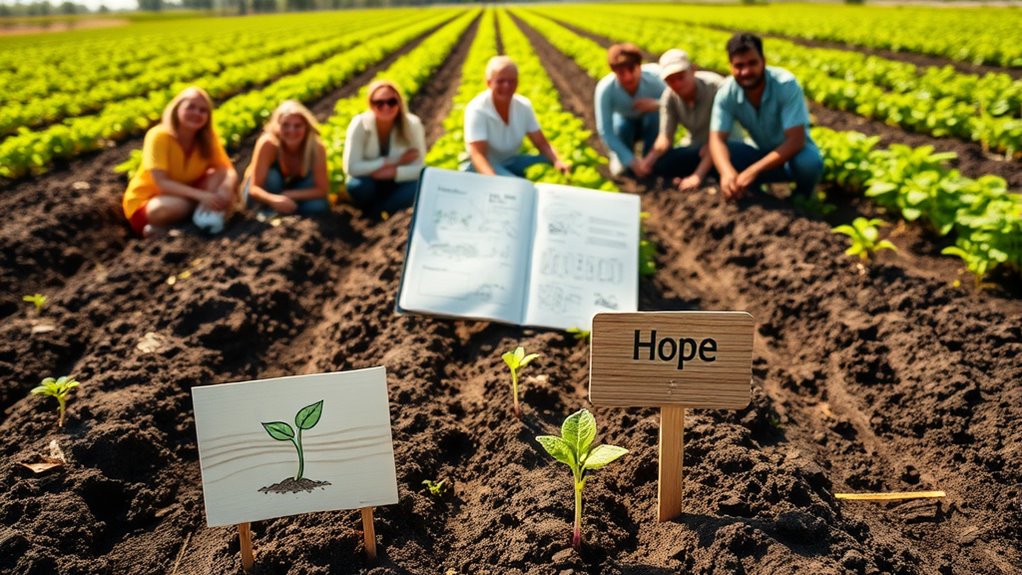
To succeed in farming, it's crucial to invest time in education and research, as they lay the groundwork for informed decision-making.
Explore online courses from the Savanna Institute or universities like Cornell and Iowa State, which offer valuable resources for beginners. Attend local workshops and seminars to gain insights into farming practices. Engaging with digital literacy programs can also enhance your ability to navigate online resources effectively. Additionally, understanding small mistakes that new farmers often make can help you avoid common pitfalls.
Consider mentorship programs through the Cooperative Extension System for hands-on experience. Conduct thorough market research to understand trends and consumer preferences, and familiarize yourself with local regulations to avoid legal issues.
Use free resources like the Greenhorns' Guidebook Series and engage in online forums to connect with seasoned farmers. Your commitment to learning will empower you to make smart and effective farming decisions. Additionally, understanding water sources in the wilderness can greatly enhance your ability to sustain your farming efforts in challenging environments.
Land Acquisition Strategies
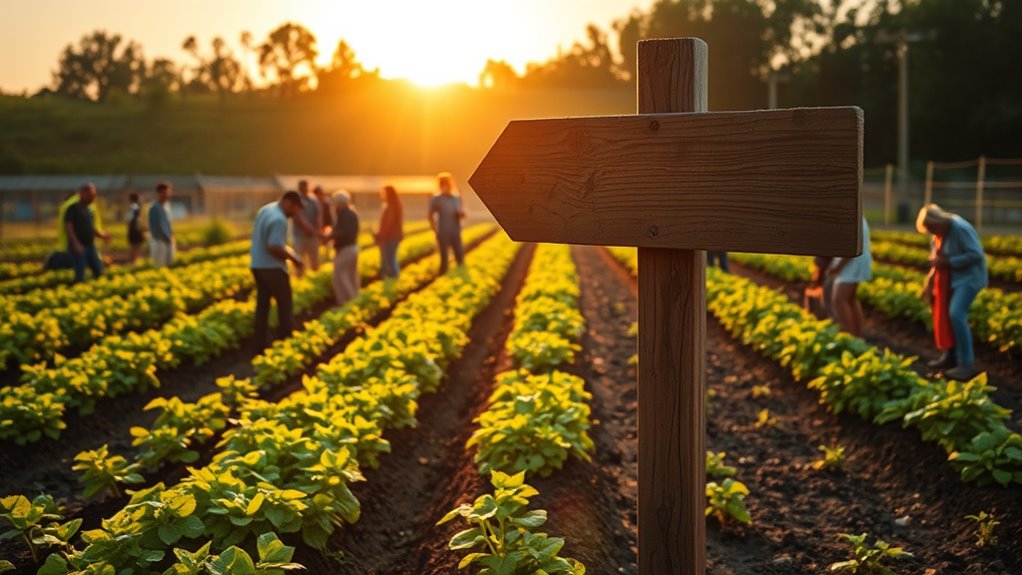
Understanding land acquisition strategies is vital for starting your farming journey without a substantial financial investment.
One effective method is owner financing, where the seller acts as a lender, allowing for negotiable terms that often don't require a traditional down payment.
Owner financing allows for flexible terms, making it easier to start your farming journey without a hefty down payment.
You might also consider leasing with an option to buy, which lets your lease payments count toward a future purchase, minimizing upfront costs.
Forming partnerships with investors or fellow farmers can provide access to capital and shared decision-making.
Additionally, explore government programs and grants that offer low or no down payment options.
Lastly, think creatively about alternative acquisition methods, such as trading services or leasing unused land, to secure your farming foundation.
It's also helpful to consider financial aid sources that may be available to support your initial farming expenses.
Starting Small and Scaling
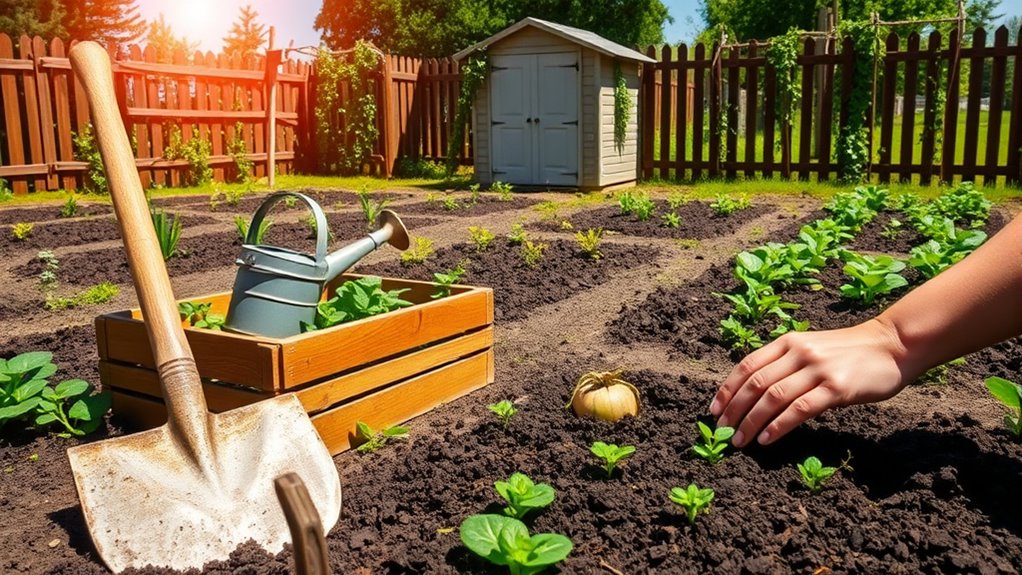
Starting small is a practical approach when diving into farming, especially if you're working with limited funds. This strategy helps you minimize initial costs while allowing for gradual growth.
Begin with high-value crops like microgreens or herbs that require minimal inputs. Rely on manual labor to keep expenses low, and start with simple crops to master farming practices. Engaging with local farming communities for support and advice as you gain hands-on experience can be invaluable. As you build your skills, consider upgrading equipment and diversifying your offerings. Moreover, focusing on nutrient density can help you select crops that offer maximum health benefits to your customers. Additionally, incorporating crops rich in omega-3 fatty acids like chia seeds can enhance the nutritional value of your produce.
Stay informed about market trends to adapt your production and maximize profits. Additionally, incorporating nutrient-rich crops can enhance the health benefits of your farm produce. By scaling gradually, you'll create a sustainable farm that can flourish over time without overwhelming financial pressure.
Building a Farm Business Plan

As you scale your small farming venture, developing a solid business plan is vital for long-term success. Start with an executive summary that outlines your mission and competitive advantage.
Then, craft a business overview with clear mission and vision statements. Conduct thorough market analysis to identify your target market, assess demand, and study competitors.
Detail your products and services to clarify what you're offering. Next, create a financial plan that includes projections, funding needs, and risk management strategies.
This plan will serve as a roadmap, guiding your operational decisions and helping you secure financing. By addressing these key components, you'll establish a strong foundation for your farming business, maximizing your chances of success.
Implementing Eco-Friendly Practices
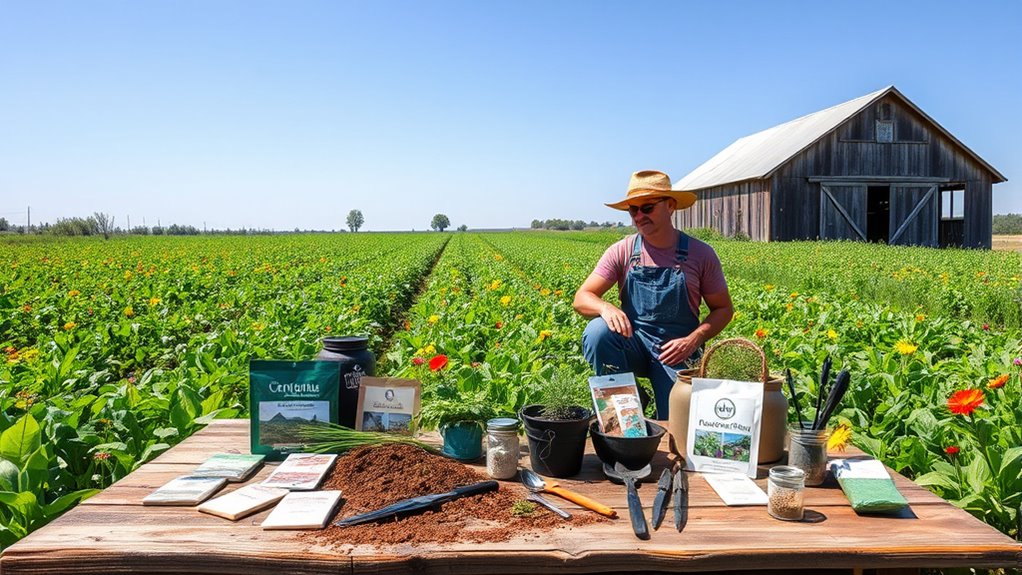
Implementing eco-friendly practices on your farm not only benefits the environment but can also enhance your crop yields and reduce costs.
Start by composting organic waste to create nutrient-rich soil amendments while reducing landfill waste. Rotate your crops to prevent nutrient depletion and minimize pest cycles. Use cover cropping to enhance soil health and prevent erosion. Additionally, consider using solar-powered irrigation systems to improve efficiency and crop yields. High vibrational energy can also positively influence the growth of your crops, aligning them with your desired outcomes.
Adopt integrated pest management to control pests sustainably, and consider agroforestry to increase biodiversity. Utilize rainwater harvesting and drip irrigation to conserve water while optimizing growth. Apply organic mulching to retain soil moisture and suppress weeds. Additionally, understanding foraging behavior can help you identify local edible plants that can supplement your farming efforts. By integrating these sustainable practices, you'll build a resilient farm that thrives while protecting the planet's resources.
Community Engagement and Support

Building a sustainable farm isn't just about eco-friendly practices; it also involves fostering strong community connections. Start by joining local farming groups to gain insights and resources.
Participate in workshops to learn new techniques and meet fellow farmers. Collaborate on community projects to share costs and improve efficiency. Engaging with schools can teach kids about sustainability while building local support.
Engage with local workshops and community projects to enhance your farming skills and foster lasting connections.
Attend community events to expand your network further.
Don't forget to tap into government programs like the USDA for educational resources and grants. Cooperatives can also be a game-changer, providing shared resources and market access.
Finally, utilize online forums for advice and mentorship opportunities to strengthen your farming journey. Your community can be your greatest asset.
Frequently Asked Questions
What Are the Best Farming Tools for Beginners?
When you're starting out in farming, having the right tools is crucial. A broadfork helps you loosen soil without disturbing its structure, while a bed preparation rake ensures even soil amendment distribution.
Garden pruners are versatile for trimming and harvesting. You'll need a wheelbarrow for transporting materials and a watering can for small areas.
Investing in these essential tools will set you up for success as you begin your farming journey.
How Can I Find Farming Mentors or Support Networks?
Finding farming mentors and support networks is easier than you think. Start by checking out local agricultural extension services or cooperative programs—they're like your modern-day farming sage!
Join associations like the National Young Farmers Coalition or Future Farmers of America for networking opportunities. Don't forget about apprenticeships; they'll give you hands-on experience.
Attend workshops, engage with community-supported agriculture, and connect through online platforms to build valuable relationships in the farming community.
What Permits or Licenses Do I Need to Start Farming?
To start farming, you'll need various permits and licenses.
First, get a Federal Tax ID Number for tax purposes.
Check with your state's Department of Agriculture for any specific state licenses required.
You may also need local permits related to zoning and environmental regulations.
If you plan to sell products directly, ensure you understand any additional licenses needed for processed foods or farmers market sales.
Always confirm local rules to stay compliant.
How Do I Deal With Pests Naturally Without Chemicals?
You can deal with pests naturally by incorporating companion planting, such as marigolds with tomatoes or basil with lettuce, to deter harmful insects.
Encourage beneficial predators like ladybugs and birds by providing habitats.
Utilize organic pesticides, like neem oil or horticultural oil, to target pests without harming beneficial species.
Additionally, practice crop rotation and cover cropping to improve soil health, creating an environment that's less hospitable for pests.
What Insurance Options Are Available for New Farmers?
Imagine your farm as a ship sailing through unpredictable waters; insurance is your sturdy anchor.
As a new farmer, you've got crop, liability, property, and workers' compensation insurance options waiting to shield you from storms.
You can also explore health plans through associations or the marketplace, ensuring your crew stays healthy.
Conclusion
So, here you are, ready to dive into farming with zero dollars to your name—sounds like a recipe for disaster, right? But with creativity and determination, you can turn that empty pocket into a thriving farm. By leveraging your resources, choosing the right crops, and engaging with your community, you'll realize that starting from scratch can be your greatest asset. Who knew that farming without funds could lead to the richest experiences of your life?

